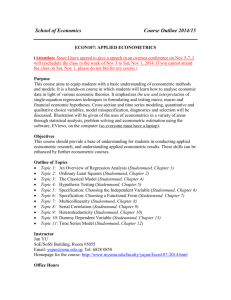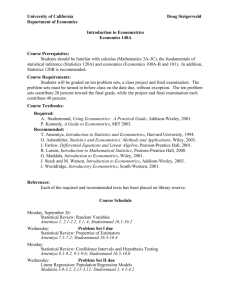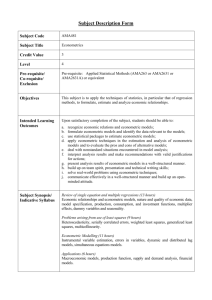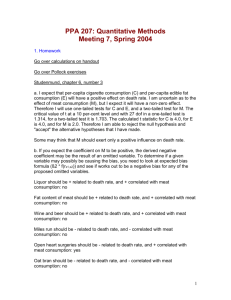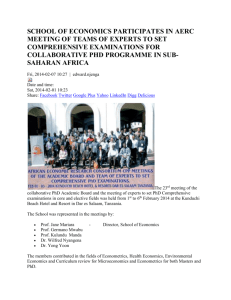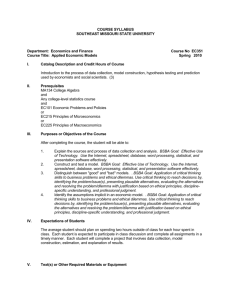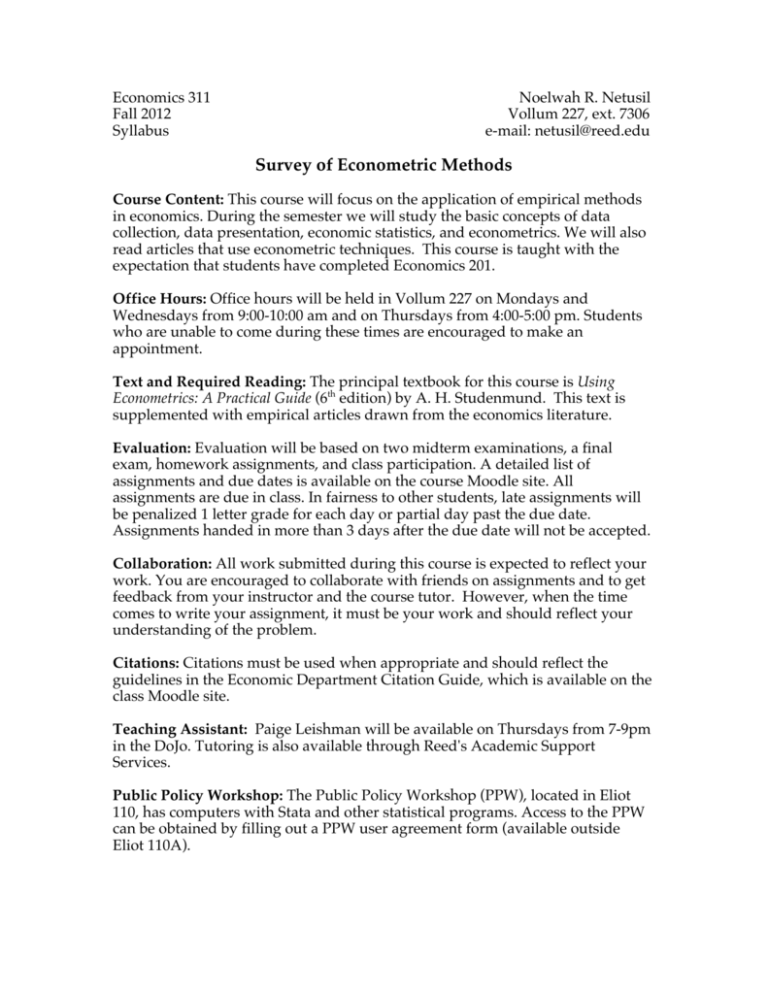
Economics 311
Fall 2012
Syllabus
Noelwah R. Netusil
Vollum 227, ext. 7306
e-mail: netusil@reed.edu
Survey of Econometric Methods
Course Content: This course will focus on the application of empirical methods
in economics. During the semester we will study the basic concepts of data
collection, data presentation, economic statistics, and econometrics. We will also
read articles that use econometric techniques. This course is taught with the
expectation that students have completed Economics 201.
Office Hours: Office hours will be held in Vollum 227 on Mondays and
Wednesdays from 9:00-10:00 am and on Thursdays from 4:00-5:00 pm. Students
who are unable to come during these times are encouraged to make an
appointment.
Text and Required Reading: The principal textbook for this course is Using
Econometrics: A Practical Guide (6th edition) by A. H. Studenmund. This text is
supplemented with empirical articles drawn from the economics literature.
Evaluation: Evaluation will be based on two midterm examinations, a final
exam, homework assignments, and class participation. A detailed list of
assignments and due dates is available on the course Moodle site. All
assignments are due in class. In fairness to other students, late assignments will
be penalized 1 letter grade for each day or partial day past the due date.
Assignments handed in more than 3 days after the due date will not be accepted.
Collaboration: All work submitted during this course is expected to reflect your
work. You are encouraged to collaborate with friends on assignments and to get
feedback from your instructor and the course tutor. However, when the time
comes to write your assignment, it must be your work and should reflect your
understanding of the problem.
Citations: Citations must be used when appropriate and should reflect the
guidelines in the Economic Department Citation Guide, which is available on the
class Moodle site.
Teaching Assistant: Paige Leishman will be available on Thursdays from 7-9pm
in the DoJo. Tutoring is also available through Reed's Academic Support
Services.
Public Policy Workshop: The Public Policy Workshop (PPW), located in Eliot
110, has computers with Stata and other statistical programs. Access to the PPW
can be obtained by filling out a PPW user agreement form (available outside
Eliot 110A).
Materials on Reserve: The following texts and manuals are on reserve in the
Reed Library.
Studenmund, A.H. 2011. Using Econometrics: A Practical Guide (6th edition)
Boston, MA: Pearson Addison Wesley.
Gujarati, Damodar N. 1995. Basic Econometrics (3rd edition) New York, NY:
McGraw-Hill.
Kennedy, Peter. 1998. A Guide to Econometrics (4th edition) Cambridge, MA:
MIT Press. <eBook >
Smith, Gary. 1998. Introduction to Statistical Reasoning New York, NY:
McGraw-Hill
Tufte, Edward R. 1997. Visual Explanations Cheshire, CT: Graphics Press
Tufte, Edward R. 2006. Beautiful Evidence Cheshire, CT: Graphics Press
Outline and Reading List
I. Introduction and Overview of Regression Analysis (August 27 and 29)
Studenmund, Chapter 1
Best, Joel. 2001. Telling the Truth about Damned Lies and Statistics The
Chronicle of Higher Education (May 4): B7-B9.
Matthews, Dylan. 2012. The Romney Campaign Says Stimulus Doesn’t Work.
Here Are the Studies They Left Out. The Washington Post (August 8).
II. Ordinary Least Squares (August 31 and September 5)
Studenmund, Chapter 2
III. Running Regressions (September 7, 10 and 12)
Studenmund, Chapter 3
Stata Corporation. 2012. Stata Reference Manuals and User Guide (Release
12) College Station, Texas: Stata Press.
IV. Classical Model (September 14 and 17)
Studenmund, Chapter 4
2
V. Probability and Statistics (September 19, 21 and 24)
Studenmund, Chapter 17
*Smith, Gary. 1998. Introduction to Statistical Reasoning New York, NY:
McGraw-Hill
VI. Hypothesis Testing (September 26, 28 and October 1)
Studenmund, Chapter 5 & Appendix
Gwartney, James and Charles Haworth. 1974. Employer Costs and
Discrimination: The Case of Baseball. Journal of Political Economy 82(4): 873882.
Midterm 1: October 3
VII. Model Specification (October 5, 8, 10 and 12)
Studenmund, Chapter 6 & Appendix
Studenmund, Chapter 7
VIII. Multicollinearity (October 22, 24 and 26)
Studenmund, Chapter 8 & Appendix
Deere, Donald, Kevin M. Murphy and Rinis Welch. 1995. Employment and
the 1990-1991 Minimum-Wage Hike The American Economic Review 85(2): 232237.
IX. Serial Correlation (October 29 and 31)
Studenmund, Chapter 9
X. Heteroskedasticity (November 2 and 5)
Studenmund, Chapter 10
XI. Regression User's Handbook & Presentation of Results (November 7)
Studenmund, Chapter 11 & Appendix
Tufte, Edward. 1997. Visual Explanations Chapter 2.
Tufte, Edward. 2006. Beautiful Evidence Pages 122-155.
Midterm 2: November 9
3
XII. Time Series Models (November 12, 14 and 16)
Studenmund, Chapter 12
Feldstein, Martin. 1996. Social Security and Saving: New Time Series
Evidence National Tax Journal 49(2): 151-164.
XIII. Dummy Dependent Variable Models (November 19 and 21)
Studemund, Chapter 13
Chaloupka, Frank J. and Henry Wechsler. 1996. Binge Drinking in College:
The Impact of Price, Availability, and Alcohol Control Policies Contemporary
Economic Policy 14(4): 112-123.
Leonhardt, David. 2005. To Reduce the Cost of Teenage Temptation, Why
Not Just Raise the Price of Sin? The New York Times (July 25): C3.
XIV. Simultaneous Equations (November 26 and 28)
Studenmund, Chapter 14 & Appendix
The Economist. 2009. Economics Focus: Cause and Defect (August 15): 68.
XV. Forecasting (November 30 and December 3)
Studenmund, Chapter 15
The Economist. 1992. America Extrapolated: Tomorrow Will Be Different (Dec
21 - Jan 3) 25-27.
Fair, Ray C. 1996. Econometrics and Presidential Elections Journal of Economic
Perspectives 10(3): 89-102.
XVI. Experimental and Panel Data (December 5)
Studenmund, Chapter 16
*Coutemanche, Charles. 2011. A Silver Lining? The Connection Between
Gasoline Prices and Obesity. Economic Inquiry 49 (3) 935-957.
Final Exam: Monday, December 10th from 1-4pm
4

